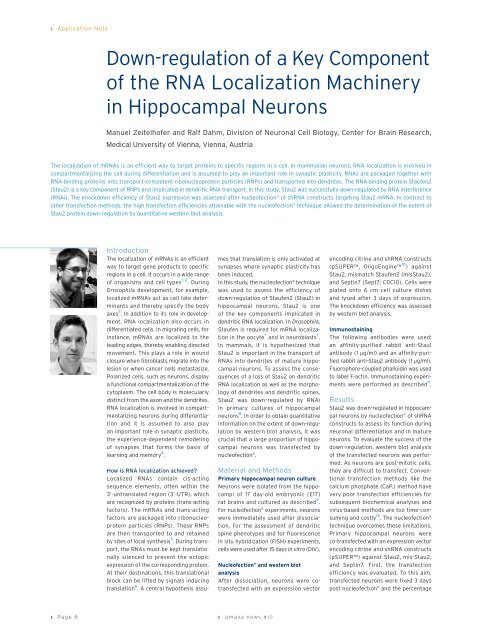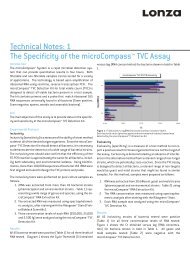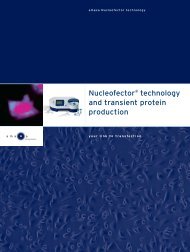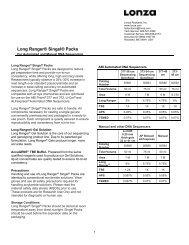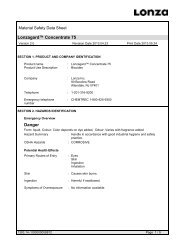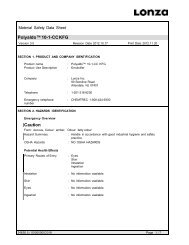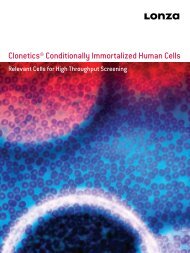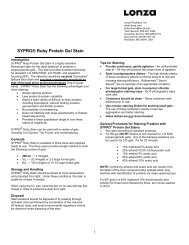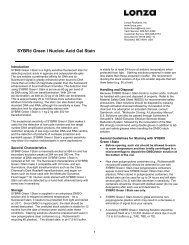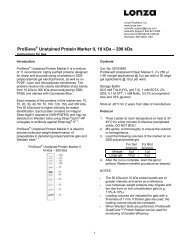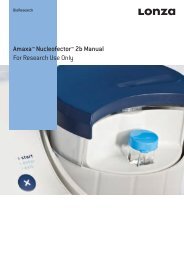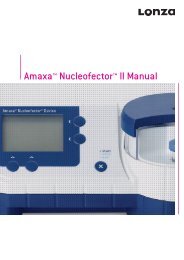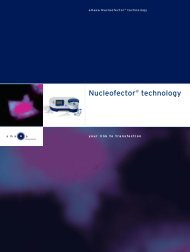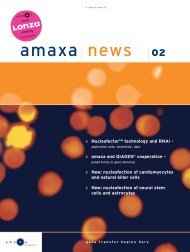amaxa news #10 - Lonza AG
amaxa news #10 - Lonza AG
amaxa news #10 - Lonza AG
You also want an ePaper? Increase the reach of your titles
YUMPU automatically turns print PDFs into web optimized ePapers that Google loves.
› Application Note<br />
Down-regulation of a Key Component<br />
of the RNA Localization Machinery<br />
in Hippocampal Neurons<br />
Manuel Zeitelhofer and Ralf Dahm, Division of Neuronal Cell Biology, Center for Brain Research,<br />
Medical University of Vienna, Vienna, Austria<br />
The localization of mRNAs is an efficient way to target proteins to specific regions in a cell. In mammalian neurons, RNA localization is involved in<br />
compartmentalizing the cell during differentiation and is assumed to play an important role in synaptic plasticity. RNAs are packaged together with<br />
RNA-binding proteins into transport-competent ribonucleoprotein particles (RNPs) and transported into dendrites. The RNA-binding protein Staufen2<br />
(Stau2) is a key component of RNPs and implicated in dendritic RNA transport. In this study, Stau2 was successfully down-regulated by RNA interference<br />
(RNAi). The knockdown efficiency of Stau2 expression was assessed after nucleofection ® of shRNA constructs targeting Stau2 mRNA. In contrast to<br />
other transfection methods, the high transfection efficiencies attainable with the nucleofection ® technique allowed the determination of the extent of<br />
Stau2 protein down-regulation by quantitative western blot analysis.<br />
Introduction<br />
The localization of mRNAs is an efficient<br />
way to target gene products to specific<br />
regions in a cell. It occurs in a wide range<br />
of organisms and cell types 1, 2 . During<br />
Drosophila development, for example,<br />
localized mRNAs act as cell fate determinants<br />
and thereby specify the body<br />
axes 3 . In addition to its role in development,<br />
RNA localization also occurs in<br />
differentiated cells. In migrating cells, for<br />
instance, mRNAs are localized to the<br />
leading edges, thereby enabling directed<br />
movement. This plays a role in wound<br />
closure when fibroblasts migrate into the<br />
lesion or when cancer cells metastasize.<br />
Polarized cells, such as neurons, display<br />
a functional compartmentalization of the<br />
cytoplasm. The cell body is molecularly<br />
distinct from the axon and the dendrites.<br />
RNA localization is involved in compartmentalizing<br />
neurons during differentiation<br />
and it is assumed to also play<br />
an important role in synaptic plasticity,<br />
the experience-dependent remodeling<br />
of synapses that forms the basis of<br />
learning and memory 4 .<br />
How is RNA localization achieved?<br />
Localized RNAs contain cis-acting<br />
sequence elements, often within the<br />
3’-untranslated region (3’-UTR), which<br />
are recognized by proteins (trans-acting<br />
factors). The mRNAs and trans-acting<br />
factors are packaged into ribonucleoprotein<br />
particles (RNPs). These RNPs<br />
are then transported to and retained<br />
by sites of local synthesis 5 . During transport,<br />
the RNAs must be kept translationally<br />
silenced to prevent the ectopic<br />
expression of the corresponding protein.<br />
At their destinations, this translational<br />
block can be lifted by signals inducing<br />
translation 6 . A central hypothesis assu-<br />
mes that translation is only activated at<br />
synapses where synaptic plasticity has<br />
been induced.<br />
In this study, the nucleofection ® technique<br />
was used to assess the efficiency of<br />
down-regulation of Staufen2 (Stau2) in<br />
hippocampal neurons. Stau2 is one<br />
of the key components implicated in<br />
dendritic RNA localization. In Drosophila,<br />
Staufen is required for mRNA localization<br />
in the oocyte 7 and in neuroblasts 7 .<br />
In mammals, it is hypothesized that<br />
Stau2 is important in the transport of<br />
RNAs into dendrites of mature hippocampal<br />
neurons. To assess the consequences<br />
of a loss of Stau2 on dendritic<br />
RNA localization as well as the morphology<br />
of dendrites and dendritic spines,<br />
Stau2 was down-regulated by RNAi<br />
in primary cultures of hippocampal<br />
neurons 8 . In order to obtain quantitative<br />
information on the extent of down-regulation<br />
by western blot analysis, it was<br />
crucial that a large proportion of hippocampal<br />
neurons was transfected by<br />
nucleofection ® .<br />
Material and Methods<br />
Primary hippocampal neuron culture<br />
Neurons were isolated from the hippocampi<br />
of 17 day-old embryonic (E17)<br />
rat brains and cultured as described 9 .<br />
For nucleofection ® experiments, neurons<br />
were immediately used after dissociation.<br />
For the assessment of dendritic<br />
spine phenotypes and for fluorescence<br />
in situ hybridization (FISH) experiments,<br />
cells were used after 15 days in vitro (DIV).<br />
Nucleofection ® and western blot<br />
analysis<br />
After dissociation, neurons were cotransfected<br />
with an expression vector<br />
› Page 8 › <strong>amaxa</strong> <strong>news</strong> # 10<br />
encoding citrine and shRNA constructs<br />
(pSUPER, OligoEngine 10 ) against<br />
Stau2, mismatch Staufen2 (misStau2),<br />
and Septin7 (Sept7; CDC10). Cells were<br />
plated onto 6 cm cell culture dishes<br />
and lysed after 3 days of expression.<br />
The knockdown efficiency was assessed<br />
by western blot analysis.<br />
Immunostaining<br />
The following antibodies were used:<br />
an affinity-purified rabbit anti-Stau1<br />
antibody (1 µg/ml) and an affinity-purified<br />
rabbit anti-Stau2 antibody (1 µg/ml).<br />
Fluorophore-coupled phalloidin was used<br />
to label F-actin. Immunostaining experiments<br />
were performed as described 11 .<br />
Results<br />
Stau2 was down-regulated in hippocampal<br />
neurons by nucleofection ® of shRNA<br />
constructs to assess its function during<br />
neuronal differentiation and in mature<br />
neurons. To evaluate the success of the<br />
down-regulation, western blot analysis<br />
of the transfected neurons was performed.<br />
As neurons are post-mitotic cells,<br />
they are difficult to transfect. Conventional<br />
transfection methods like the<br />
calcium phosphate (CaPi) method have<br />
very poor transfection efficiencies for<br />
subsequent biochemical analyses and<br />
virus-based methods are too time-consuming<br />
and costly 12 . The nucleofection ®<br />
technique overcomes these limitations.<br />
Primary hippocampal neurons were<br />
co-transfected with an expression vector<br />
encoding citrine and shRNA constructs<br />
(pSUPER) against Stau2, mis-Stau2,<br />
and Septin7. First, the transfection<br />
efficiency was evaluated. To this aim,<br />
transfected neurons were fixed 3 days<br />
post nucleofection ® and the percentage


